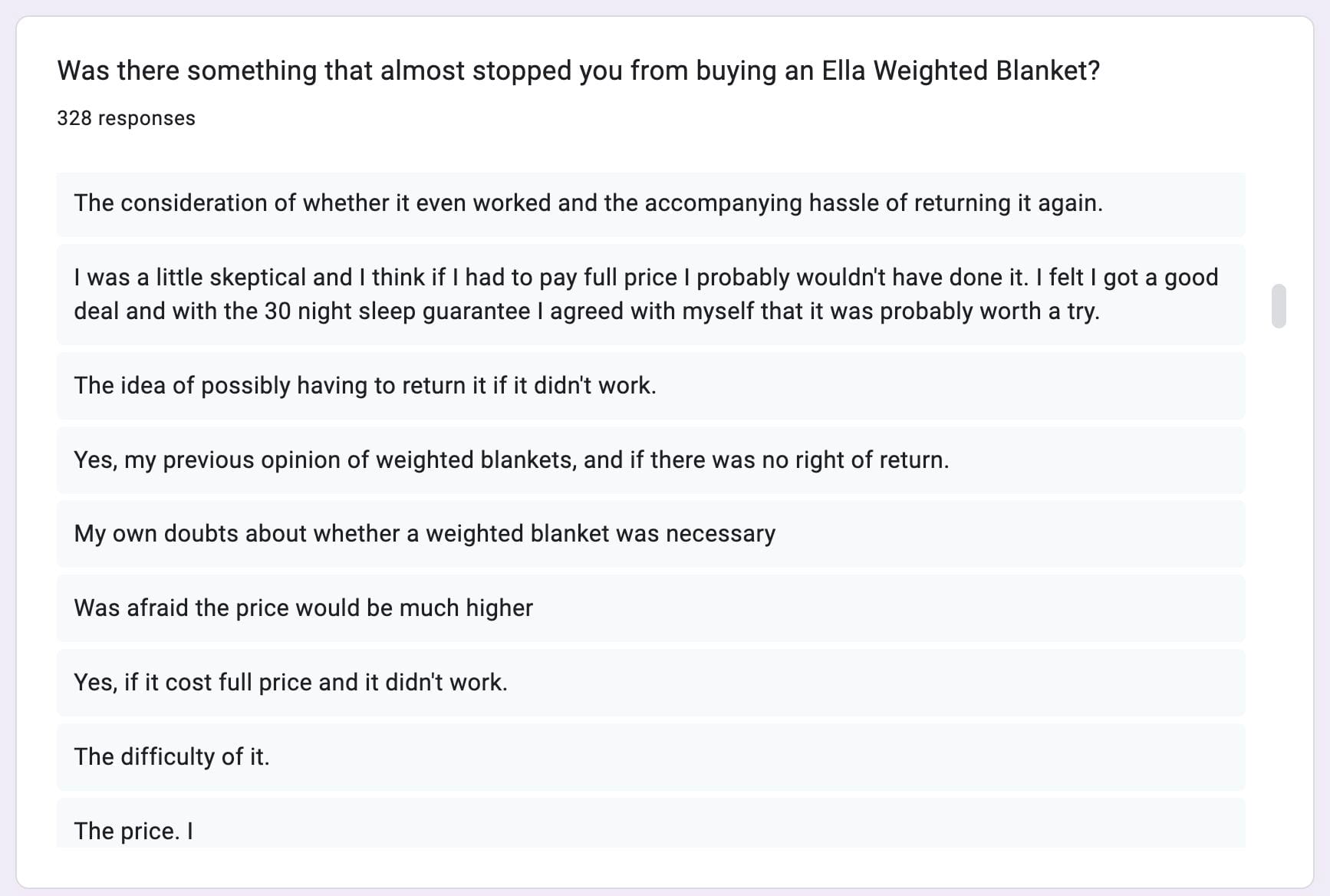I've been using a different strategy to overcome customer hesitation and improve conversion rate. Here's what it's done for my store, and how you can use it too.
The fastest way to improve your conversion rate both on your site and in your ads is by finding out your customers' limiting buying beliefs and addressing them head-on.
At anew sleep, we discovered this after months of watching customers abandon carts at checkout. Our analytics showed when they left, but not why. So we simply asked them.
That one question revealed patterns we'd never seen: specific doubts and exactly what convinced people to buy. Marketers call this Zero-Party Data (ZPD). It is information customers willingly share about their preferences and concerns.
Why Zero-Party Data Matters
Look, I used to obsess over analytics, but that data only showed what customers did, never why. When someone tells you "I almost didn't buy because X," you've discovered gold for every marketing message you'll write.
At anew sleep, ZPD has completely changed how we market:
- Our ad copy now uses customers' exact phrases
- Our product pages address specific doubts
- Our ROAS improved as we stopped wasting money on messages that didn't matter
The best part? While other brands scramble to deal with iOS updates and cookie deprecation, ZDP is helping us build a direct line to our customers' needs.
Our Zero-Party Data Process
Let me show you exactly how we do this at anew sleep. We've built our approach around the moments when customers are most open to sharing their thought. Essentially, we tend to:
Step 1: Ask Right After Purchase
The moment someone clicks “buy,” we show them a quick form with questions like:
1. Where did you first hear about us?
2. What made you order with us today?
We keep it short so it doesn’t feel like homework. But these two questions alone reveal a lot about which channels are paying off and what messaging actually triggered the purchase decision. It’s “zero-party” because the customer is volunteering their thoughts with no behind-the-scenes data scraping.
Step 2: Follow Up Post-Delivery
After a customer receives our Ella Weighted Blanket (and hopefully sleeps like a baby for a few nights), we send out a more detailed survey with about 15 questions total.
The real magic question we sprinkle in is:
Was there something that almost stopped you from buying?
We’ve received hundreds of responses, and they’re pure gold. People mention worries about returns, skepticism that a weighted blanket might not really help, concerns about price, and so on. These are direct insights into the friction points people have right before hitting the checkout button.
Here's how it looks.

Step 3: Capture Browse-to-Buy Insights
Sometimes the most valuable feedback comes from those who aren't customers yet. We place a simple exit-intent popup when someone's about to leave our product page: "Quick question before you go: What's holding you back from trying our weighted blanket?"
By catching them in that moment of hesitation, we get raw, honest feedback about what's stopping them from buying. These insights often reveal objections we never would have guessed: They're different from what we hear post-purchase.
Turning Objections into Ad Copy
Once we see that customers are afraid the blanket “won’t actually work,” we know one of the biggest barriers is skepticism. Now, instead of our ads glossing over that fact, we lean into it. We’ll run ad copy like:
“Not sure if a weighted blanket will help you sleep better? We get it. That’s why we offer a 30-night sleep guarantee. If you don’t love it, send it back. No questions asked.”
Suddenly, the biggest barrier becomes our biggest selling point. If returns are a fear, we highlight how easy the process is. If price is the worry, we discuss the cost of poor sleep versus the investment in better rest or explain our financing options.
Essentially, we’re taking the exact words people used to describe their concerns and addressing them right in our creative.
The Payoff: Higher Conversion & Easier Scaling
What’s the point of all this? A better return on your ad spend (ROAS) and a smoother path to scaling. When you systematically remove your audience’s doubts before they derail the sale, your ads convert more effectively.
More conversions mean you can afford to spend more on acquisition without wrecking profitability. I’ve watched our CPAs stay steady (and sometimes even drop) as we increased budgets, simply because the creative was so dialed in to customer objections.
How You Can Do This Too
The best part about zero-party data? You can start collecting it today. Here's the exact process we use. Feel free to steal it:
1. Identify the Touchpoints
Figure out where you can collect zero-party data. Is it a post-purchase page, an email survey, or a quiz on your site? Keep it simple and low-friction.
At anew sleep, we use three key moments: our post-purchase confirmation page (highest response rate), our "how did you sleep?" email after delivery (great for detailed feedback), and our product recommendation quiz for first-time visitors (works well when we offer a small discount).
2. Ask the Golden Questions
“Was there something that almost stopped you from buying?” This is where you’ll find the real objections nobody posts publicly on social media but definitely thinks about in their head.
Our highest-converting questions are dead simple: "What almost stopped you from buying?" and "What finally convinced you?" We tested longer surveys but found shorter ones work better. Sometimes one perfect question beats a dozen good ones.
3. Incorporate Customer Language
Use their words in your ad headlines and body copy. If 50 people say "I was skeptical," then don't be afraid to lead with, "Still skeptical? Here's why you don't have to be."
For example, one of the most common concerns we saw was "What if I feel trapped under it?" We addressed this by featuring stories from customers who shared the same worry but found the weight calming instead of restricting. Their words carried more weight than any product feature we could list.
Every product has these moments of hesitation. Those real, honest doubts that customers think about before buying. When you reflect these back in their own words, something clicks. They feel heard, not marketed to
4. Refresh Your Creative Regularly
As you gather more feedback, keep updating your messaging. New objections might surface or old ones might shift. Stay on top of the conversation.
We update our ad creative based on new responses regularly. Recently, we noticed more customers mentioning summer heat concerns. We quickly created new ads addressing temperature regulation, speaking directly to that worry. Your customers' concerns evolve and your messaging should too.
5. Scale Confidently
With objections preemptively answered, your ads have a better shot at profitable conversions even at higher budgets.
When we scaled our ad spend, our cost per acquisition stayed manageable and much better than our previous attempts at scaling. Instead of watching our metrics get worse with higher spend, we maintained performance.
The reason is simple: When your ads speak directly to customer concerns, they convert better at every level. You're not just reaching more people:
You're reaching them with messages that actually resonate. That's how zero-party data turns into a true scaling advantage.
Start Building Your Zero-Party Feedback Loop
I like to say that zero-party data is your cheat sheet for customer psychology. They're literally telling you what they need to hear from you in order to buy.
When you bake that feedback into your ads and onsite content, you're no longer playing the guessing game. Instead, you're solving problems your customers already told you they have. And that's how you keep your ROAS strong while pushing your budgets further.
Give it a shot.
Ask your customers what nearly stopped them from buying.
Then take those insights, craft new ad angles around them, and watch how quickly those conversions start rolling in.
You'll never look at "just another survey" the same way again.


